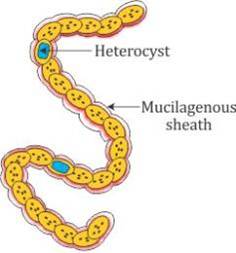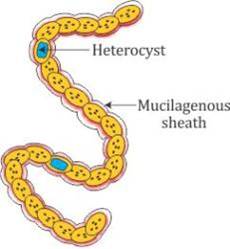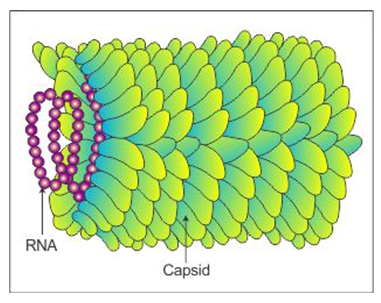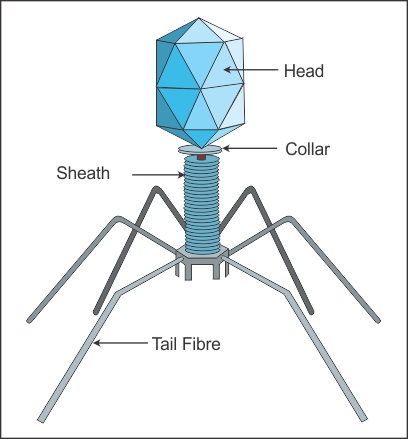Q1. Interferons are
Solution
Interferons are anti-viral, regulatory
glycoproteins which are produced in virus-infected cells for defence. They
are non-antigenic proteins weighing 2000 Da. They were discovered by Isaacs
and Lindenmann in 1957. These interferons induce formation of certain enzymes
which suppress viral multiplication in host cells and protect the host from
further viral reinfection.
Q2. In plants, mosaic formation,
leaf rolling and curling, yellowing of plant parts, vein clearing, dwarfing
and stunted growth are symptoms of
Solution
Plant virus such as cauliflower mosaic virus causes plant diseases.
The symptoms include mosaic formation, leaf rolling and curling, yellowing of
plant parts, vein clearing, dwarfing and stunted growth.
Q3. Red tide is caused by
Solution
Noctiluca, Gymnodinium and Gonyaulax are dinoflagellates. Due to their rapid multiplication, the sea appears red which is known as red tide.
Q4. Virus envelop is known as
Solution
Virus envelop is made of protein and is called a capsid. It is made of subunits called capsomeres.
Q5. Cauliflower
mosaic virus contains
Solution
Cauliflower mosaic virus (CMV) also called caulimovirus contains double-stranded
(ds) DNA.
Q6. Among rust, smut and mushroom, all the three
Solution
Rust, smut and mushroom belong to phylum basidiomycetes of kingdom Fungi. Basidiomycetes decompose the woody structure of trees. They decompose cellulose and lignin. Rusts are parasitic on certain species of wheat and coffee. Smuts infect corn, wheat etc., and mushrooms are parasitic on the bark and roots of certain trees.
Q7. Why are deuteromycetes called imperfect fungi?
Solution
Only asexual and vegetative phases of deuteromycetes are known; hence, they are called imperfect fungi.
Q8. Which of the following is a prokaryote?
Solution
Bacteria belong to kingdom Monera, and it is a prokaryote. A prokaryote does not have membrane-bound cell organelles.
Q9. Which one does not possess nucleic acid?
Solution
Prions are abnormally folded proteins which are made of amino acids.
Nucleic acids are used in the reproduction of DNA and play a role in
protein synthesis, but they are not directly embedded into the protein.
Therefore, prions do not contain any nucleic acid (or genetic
information) within them.
Q10. Single-celled eukaryotes are included in
Solution
Unicellular eukaryotes (except some unicellular algae and fungi) are grouped under kingdom Protista. Protists are considered as the phylogenetic link between kingdom Monera and multicellular eukaryotic organisms.
Q11. Draw a well-labelled diagram of Nostoc.
Solution

Q12. Name the group of fungi which are also known as sac fungi.
Solution
Ascomycetes
Q13. Virus was placed in
Solution
Viruses do not belong to any kingdom in biological classification. Viruses are inert when outside the living cell. They are active and can replicate only when they infect the host cell.
Q14. What is diatomaceous earth?
Solution
The accumulation of large amounts of cell wall deposits left back by diatoms over billions of years is called diatomaceous earth.
Q15. Which of the following are intracellular obligate parasites?
Solution
An obligate parasite cannot complete its life cycle without a suitable host. Viruses infect a cell, take the machinery of the cell and replicate. Hence, they are intracellular obligatory parasites.
Q16. Lichens are described as indicators of
Solution
Lichens do not grow in polluted air. Hence, the regions where there is minimal growth of lichens despite the suitable condition for their growth may indicate increased pollution in that region.
Q17. Who proposed Contagium vivum fluidum?
Solution
M. W. Beijerinck demonstrated that the extract of infected tobacco plant can infect the healthy plant. He named this extract as Contagium vivum fluidum.
Q18. The influenza virus has
Solution
Influenza virus is single stranded RNA virus, which cannot serve directly as mRNA but rather as templates for mRNA synthesis via viral transcriptase.
Q19. Nuclear membrane is absent in
Solution
Monerans are prokaryotic organisms. Prokaryotic cells do not have membrane-bound organelles and a distinct nucleus bound by the nuclear membrane.
Q20. Write a short note on Cyanobacteria.
Solution
Cyanobacteria:
 They are also called blue-green algae.
They are unicellular, colonial or filamentous.
They are found in fresh or marine water. Some of them are also terrestrial.
They show the presence of rigid cell walls.
In motile cyanobacteria, flagellum is present.
Cyanobacteria are photoautotrophs and show the presence of chlorophyll a.
Cyanobacteria can fix atmospheric nitrogen in specialised cells called heterocysts.
Anabaena and Nostoc are examples of cyanobacteria.
They are also called blue-green algae.
They are unicellular, colonial or filamentous.
They are found in fresh or marine water. Some of them are also terrestrial.
They show the presence of rigid cell walls.
In motile cyanobacteria, flagellum is present.
Cyanobacteria are photoautotrophs and show the presence of chlorophyll a.
Cyanobacteria can fix atmospheric nitrogen in specialised cells called heterocysts.
Anabaena and Nostoc are examples of cyanobacteria.
 They are also called blue-green algae.
They are unicellular, colonial or filamentous.
They are found in fresh or marine water. Some of them are also terrestrial.
They show the presence of rigid cell walls.
In motile cyanobacteria, flagellum is present.
Cyanobacteria are photoautotrophs and show the presence of chlorophyll a.
Cyanobacteria can fix atmospheric nitrogen in specialised cells called heterocysts.
Anabaena and Nostoc are examples of cyanobacteria.
They are also called blue-green algae.
They are unicellular, colonial or filamentous.
They are found in fresh or marine water. Some of them are also terrestrial.
They show the presence of rigid cell walls.
In motile cyanobacteria, flagellum is present.
Cyanobacteria are photoautotrophs and show the presence of chlorophyll a.
Cyanobacteria can fix atmospheric nitrogen in specialised cells called heterocysts.
Anabaena and Nostoc are examples of cyanobacteria.
Q21. Study of fungi is
Solution
Mycology is the branch of biology which deals with the study of fungi, including their properties, taxonomy and whether they are useful or harmful.
Q22. Thread-like filaments which constitute the body of fungi are
Solution
Hyphae are long, thread-like and filamentous. The network of hyphae is known as mycelium.
Q23. In the anaerobic respiration of yeast and bacteria, which of the following is released?
Solution
CO2 is released during the anaerobic respiration of yeast and bacteria. During anaerobic respiration, sugars are converted or oxidised into ethanol or lactic acid.
Q24. Difference between virus and viroid is
Solution
In viruses, the genetic material can be RNA or DNA which is enclosed by the capsid. In viroids, the genetic material is RNA which is free and not enclosed by any protein coat.
Q25. Who proposed the five kingdom classification?
Solution
R. H. Whittaker, an American ecologist, proposed the five kingdom classification. He divided organisms into five kingdoms—Monera, Protista, Fungi, Animalia and Plantae.
Q26. Fungi are always
Solution
Fungi are heterotrophs. They can be saprophytic, parasitic or symbiotic.
Q27. Conidia and ascospores are produced by ascomycetes, still they are different from each other. Justify.
Solution
Conidia are asexual spores. They are produced exogenously on conidiophores. On germination, they produce mycelium.
Ascospores are sexual spores. They are produced endogenously in a sac-like structure called ascus.
Q28. Heterotrophic fungi can live as
Solution
Saprotrophic fungi absorb organic matter from dead and decaying plants or animals.
Some fungi such as rusts and smuts grow as parasites on certain crops such as wheat and corn by decomposing their cellulose.
In lichens, the mycobiont part, i.e. fungi are in symbiotic association with the phycobiont part, i.e. algae.
Q29. Viruses are non-cellular organisms but replicate themselves when they infect the host cell. To which of the following kingdoms do viruses belong?
Solution
Viruses do not belong to any kingdom in biological classification. Viruses are inert when outside the living cell. They are active and can replicate only when they infect the host cell.
Q30. Write the name of fungi which is used extensively in genetic work.
Solution
Neurospora
Q31. What is mycoplasma?
Solution
Mycoplasma is an organism which lacks a cell wall
It is included in kingdom Monera.
It is anaerobic.
It is pathogenic for many plants and animals.
Q32. What is Plasmodium?
Solution
Plasmodium is the aggregation of slime moulds which grow and spread on a large area over several feet under suitable conditions.
Q33. Differentiate between ascomycetes and basidiomycetes.
Solution
Ascomycetes
Basidiomycetes
(i) Ascomycetes are saprophytic, decomposers, parasitic or coprophilous.
(i) Basidiomycetes are parasites.
(ii) They produce ascospores and conidia.
(ii) They produce basidiospores.
(iii) Ascospores are produced endogenously in asci.
(iii) Basidiospores are produced exogenously on the basidia.
(iv) Asexual reproduction is by conidia.
(iv) Asexual reproduction is absent.
Q34. Rhizopus belongs to
Solution
Rhizopus belongs to zygomycetes of kingdom Fungi. Fungi which belong to the group zygomycetes show the presence of septate mycelium, sporangia at the tips of hyphae, sexual reproduction by conjugation and absence of non-motile zoospores.
Q35. The beautiful diatoms and desmids are placed under
Solution
Diatoms and desmids are placed under Chrysophytes (Kingdom: Protista).
Q36. Common bread mould is
Solution
Rhizopus is a saprophytic fungus. It spoils food items such as bread, strawberries, apples etc. It is frequently observed growing on bread and is hence also called common bread mould.
Q37. The accumulated food reserve in fungi is
Solution
Fungi are saprophytes, i.e. they absorb soluble organic substances from dead and decaying matter. In fungi, the food is stored in the form of glycogen and oil droplets.
Q38. Give one example of flagellate protozoan.
Solution
Trypanosoma
Q39. Mycorrhizae show
Solution
Mycorrhiza is the symbiotic association of fungus with the roots of higher plants. The fungus receives food and shelter from the tree. In return, the fungus absorbs water and minerals from the soil and transports it to the tree, thus helping the tree to grow.
Q40. Desmids are also called
Solution
Pigment fucoxanthin present in desmids imparts a golden-brown colour. Hence, they are also called golden algae.
Q41. Write about the contributions of the following scientists:
M. W. Beijerinck
W. M. Stanley
Solution
M. W. Beijerinck: He demonstrated that the extract of an infected tobacco plant causes infection in a healthy plant. He called this fluid as contagium vivum fluidum.
W. M. Stanley: He showed that viruses could be crystallised and the crystals are largely made of proteins.
Q42. Name the protein-rich layer in Euglena which replaces the cell wall.
Solution
Pellicle
Q43. A virus is considered a
living organism and an obligate parasite when inside a host cell. However, a virus
is not classified along with bacteria or fungi. What are the characters of a virus
which are similar to non-living objects?
Solution
The
characters showing that viruses are non-living:
They do not show cellular
metabolism and lack respiration.
They have no proper cellular
structure.
They are active only when
they are inside the living host cells.
Q44. Bacteria that live in hot springs are called
Solution
Thermoacidophiles are bacteria which can thrive at very high temperatures and in extreme acidic environments.
Q45. What is mycorrhiza?
Solution
Mycorrhiza is the symbioant association of fungi with the roots of higher plants.
Q46. Define hyphae.
Solution
Hyphae are long, slender, thread-like bodies of fungi.
Q47. Explain genetic material in viruses.
Solution
Viruses contain either RNA or DNA as genetic material.
The genetic material of a virus is infectious.
Viruses which infect plants have single-stranded RNA.
Viruses which infect animals have either single-stranded or double-stranded RNA or double-stranded DNA.
Bacteriophages have double-stranded DNA.
Q48. Lichens are a well-known combination of an alga and a fungus, where the fungus has
Solution
Lichens are a permanent symbiotic association between mycobiont, i.e. the fungal component, and phycobiont, i.e. the algal component.
Q49. What are lichens?
Solution
Lichens are a mutually useful symbiotic association between algae and fungi.
Q50. How is a viroid different from a virus?
Solution
A viroid lacks the protein coat which is present in a virus.
Q51. Match the following and choose the correct combination from the options given
Column I
(Group Protista)
Column II
(Example)
(a)Chrysophytes
(i)Paramecium
(b)Dinoflagellates
(ii)Euglena
(c)Euglenoids
(iii)Gonyaulax
(d)Protozoans
(iv)Diatoms
Solution
Column I
(Group Protista)
Column II
(Example - Answers)
(a)Chrysophytes
(i) Diatoms
(b)Dinoflagellates
(ii) Gonyaulax
(c)Euglenoids
(iii) Euglena
(d)Protozoans
(iv) Paramecium
Q52. Explain the terms mycobiont and phycobiont.
Solution
Mycobiont is the fungal component of a lichen which provides shelter and absorbs minerals and water for the algae.
Phycobiont is the algal component of lichen which prepares food for fungi.
Q53. When fungi feed on dead organic matter, they are known as
Solution
Fungi are saprophytes. They absorb organic constituents as their food from dead and decaying matter.
Q54. Which of the following is not the locomotory organ of protozoa?
Solution
In protozoans, locomotion occurs either by pseudopodia, cilia or flagella. Example: Amoeba has pseudopodia, paramoecium locomotes by cilia and trypanosome has flagella as their locomotory organs.
Q55. Explain the groups of protozoa.
Solution
There are four groups of protozoa:
1. Amoeboid Protozoans:
Amoeboid protozoans live in fresh or sea water or in moist soil.
They have pseudopodia to capture their prey. The body surface of marine amoeboid protozoans is covered with silica shells.
Examples: Amoeba, Entamoeba
2. Flagellated Protozoans:
Flagellated protozoans are either free-living or parasitic.
Parasitic forms cause certain diseases such as sleeping sickness.
These protozoans have flagella for locomotion.
3. Ciliated Protozoans:
These protozoans have numerous cilia on their body. Because of the cilia, they are actively moving organisms.
Cilia help in locomotion and allow food laden water to enter the organism’s body.
These organisms are aquatic.
Examples: Paramecium
4. Sporozoans:
These protozoans have an infectious spore stage in their life cycle.
They are parasites.
Example: Plasmodium (which causes malaria)
Q56. Name the organisms which were placed under kingdom Plantae before the five kingdom classification. Why?
Solution
Bacteria, cyanobacteria, fungi, mosses, ferns, gymnosperms and angiosperms were placed in kingdom Plantae because these organisms possess a cell wall.
Q57. The shape of the cocci bacteria is
Solution
Bacteria are found in four shapes—cocci (spherical, ovoid shape), bacilli (rod-shaped), spirilla (spiral shaped/coiled) and vibrio (comma-shaped).
Q58. Who discovered viroids?
Solution
T. O. Diener discovered viroids.
Q59. Write any two distinguishing characters of dinoflagellates.
Solution
1)Dinoflagellates have stiff plates of cellulose on the outer surface.
2)Their rapid multiplication gives a red appearance to the sea which is known as red tides.
Q60. Wheat rust is caused by
Solution
Puccinia is the genus of kingdom Fungi. It includes species of obligate parasites which cause serious infection called rust. These fungi cause rusty pustules on the aerial parts of crops.
Puccinia graminis tritici - black stem rust of wheat
Puccinia glumarum - yellow rust of wheat
Puccinia recondita - brown rust of wheat
Q61. Mycobiont and phycobiont are found in
Solution
Lichens are a symbiotic association between fungi and algae. The fungal component is heterotrophic and known as mycobiont, while the algal component is autotrophic and known as phycobiont.
Q62. Sexual reproduction is absent in
Solution
Deuteromycetes is a group of fungi. In them, the sexual reproduction is either absent or unknown. As and when the mode of sexual reproduction was known, the fungi were moved to either ascomycetes or basidiomycetes.
Deuteromycetes reproduce asexually by producing spores called conidia.
Q63. Tobacco mosaic
virus (TMV) genes are
Solution
Tobacco mosaic virus (TMV) is an elongated and rod-like plant virus
with 95% protein and 5% RNA. The genetic material of TMV is linear, single-stranded
and 6500 nucleotides in length.
Q64. What are coenocytic hyphae?
Solution
Hyphae which are continuous tubes filled with multinucleated cytoplasm are called coenocytic hyphae.
Q65. Describe the formation of haploid spores in fungi.
Solution
In sexually reproducing fungi, hyphae of two compatible mating types fuse.
In some fungi, the fusion of haploid cells immediately forms diploid cells (2n), but in some ascomycetes and basidiomycetes, the fusion results in an n+n stage, i.e. single cell with two nuclei. Such a condition of cell is called the dikaryon condition and the stage is known as dikaryophase.
The polar nuclei of the cells then fuse, and the cell becomes diploid.
Reduction division occurs inside the fruiting bodies resulting in the formation of fungi.
Q66. Describe the three groups of archaebacteria.
Solution
The three groups of archaebacteria are
1. Methanogens: Methanogens grow in marshy areas and in the stomach of ruminants.
Methanogens are responsible for the production of biogas from animal dung.
2. Halophiles inhabit extreme salty areas.
3. Thermoacidophiles inhabit areas which are acidic and rich in sulphur with high temperature. They are mostly found in hot springs.
Q67. One of these is not a characteristic feature of cyanobacteria.
Solution
Cyanobacteria are unicellular, colonial or filamentous organisms. They are also called blue-green algae.
Q68. Who coined the term virus?
Solution
Louis Pasteur coined the term virus.
Q69. Name the bacteria responsible for the formation of bloom in polluted water.
Solution
Cyanobacteria (Blue-Green Algae)
Q70. Explain the steps of the sexual cycle of fungi.
Solution
The sexual cycle of fungi occurs in three steps:
1.Plasmogamy: Protoplasms of two motile or non-motile gametes fuse.
2.Karyogamy: Fusion of nuclei of two gametes.
3.The zygote undergoes meiosis resulting in the formation of haploid spores.
Q71. Name any one disease caused by viroids.
Solution
Potato spindle tuber disease is caused by viroids.
Q72. Draw a labelled diagram of tobacco mosaic virus (TMV).
Solution

Q73. Draw a labelled diagram of a bacteriophage.
Solution

Q74. Give two examples of cyanobacteria.
Solution
Nostoc
Anabaena
Q75. Give any two examples of fungi which belong to group ascomycetes.
Solution
Aspergillus, Claviceps
Q76. An edible fungus is
Solution
Species of fungi from the genus Morchella are edible. They belong to the group ascomycetes. Their ascocarps are cap-like, fleshy, sponge-like and edible. They are considered a table delicacy in India and are grown in Kashmir and Punjab.
Examples: Morchella esculenta, Morchella deliciosa, Morchella crassipes
Q77. What are chemosynthetic bacteria? State their importance.
Solution
Chemosynthetic bacteria oxidise substances such as ammonia, nitrites and nitrates and use the released energy for the synthesis of ATP.
Chemosynthetic bacteria help in recycling nutrients such as phosphorus, nitrogen, sulphur, iron etc.
Q78. What are the criteria used to classify fungi in different classes?
Solution
Criteria used to classify fungi in different classes:
1. Morphology of the mycelium
2. Mode of spore formation and fruiting bodies
Q79. Name a unicellular fungus.
Solution
Yeast
Q80. What criteria were used by R. H. Whittaker for the five kingdom classification?
Solution
The criteria used by R. H. Whittaker for the five kingdom classification were cell structure, thallus organisation, mode of nutrition, reproduction and phylogenetic relationships.
Q81. Write the names of the five kingdoms proposed by Whittaker.
Solution
The five kingdoms proposed by Whittaker are Monera, Protista, Fungi, Plantae and Animalia.
Q82. Give any two examples of insectivorous plants.
Solution
Bladderwort, Venus fly trap
Q83. To which kingdom do bacteria belong?
Solution
Bacteria belong to kingdom Monera.
Q84. Write any two features of viroids.
Solution
Features of viroids:
A viroid is a free RNA of low molecular weight.
It lacks a protein coat which is found in viruses.
Q85. Define plasmogamy.
Solution
Plasmogamy is the fusion of protoplasms of motile or non-motile gametes.
Q86. Write any two features of spores of slime moulds.
Solution
Features of slime moulds:
1)Spores survive for many years under adverse conditions.
2)They possess true cell walls.
Q87. State the four categories of bacteria based on their shape.
Solution
The four categories of bacteria based on their shape are cocci, rod-shaped bacilli, comma-shaped vibrio and spiral shaped spirilla.
Q88. Explain the alternation of generation in plants.
Solution
Alternation of generation is observed in plants. Plants show two phases in their life cycle—the diploid sporophyte phase and the haploid gametophyte phase—which alternate with each other.
Comments
Post a Comment